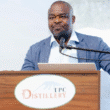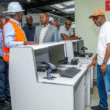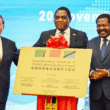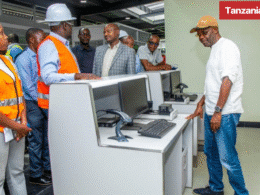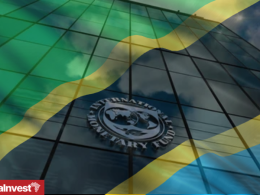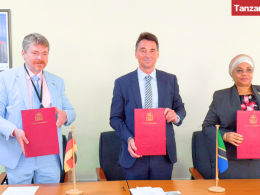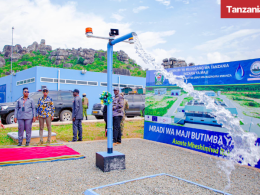The construction industry in Tanzania includes real estate, transport infrastructure, and other civil works, including water supply.
Construction contributed 13.6% to Tanzania’s GDP during 2015, reaching almost USD6b. In 2010 the sector accounted for only 7.8% of the country’s GDP or USD1.6b.
The growth rate of the Tanzanian construction sector was 4.3% in Q1 2016, compared to 23.2% in Q1 2015.
According to the Tanzania National Bureau of Statistics (NBS), the slowing of the growth rate was due to reduced investments in construction activities.
However, for the fiscal year 2016–2017 the government of Tanzania has budgeted TZS5.47t equivalent to 25.4% of the total budget, excluding public debt service, for infrastructure development projects.
Table of Contents
Tanzania Real Estate
Tanzania Housing Projects
Tanzania Public Servants Housing Scheme
Tanzania PSPF Towers
Tanzania Transport Network
Tanzania Road Transport
Tanzania Railway Transport
Tanzania Standard Gauge Railway Project
Tanzania Intermodal and Rail Development Project
Tanzania Intermodal and Rail Development Project
Tanzania Air Transport
Tanzania Water Transport
Tanzania Bagamoyo Port Development
Tanzania Mwambani Port and Railway Corridor Project
Tanzania Water Supply
Tanzania Water Supply Projects
Tanzania Kikonge Multipurpose Dam
Tanzania Construction Sector Outlook
Tanzania Real Estate
The Tanzanian real estate sector, especially housing, is mainly driven by the fast-growing Tanzanian population of around 53m, which is expected to more than double by 2050.
The demand for housing in Tanzania is estimated at 200,000 houses annually, which results in a current housing shortage of 3m houses.
The Tanzanian housing demand has been boosted by easier access to mortgages, with the number of mortgage lenders in the market increasing from 3 in 2009 to 21 in 2015.
The average mortgage interest rate in Tanzania fell from 22% to 16% during the same period.
In a recent survey on real estate in Tanzania conducted by Mikono Speakers International, the majority of Tanzanians point out that they plan to own a house in the future.
However, respondents note that houses are too expensive to buy at the moment. Accordingly, 88% of those planning to own a house prefer to build it instead of buy it.
In 2011, the cheapest house built by a private developer in Tanzania was 65 square meters (m2) at the cost of USD16,130, or USD250 per m2.
In 2015, the same house would cost USD20,992, or USD323 per m2, representing an increase of 30%. At the same time, the cost of a 50kg bag of cement in Tanzania fell from USD9 in 2011 to USD7 in 2015.
Accordingly, it would cost 12.4% of the average urban annual income in Tanzania to afford the cement needed to build a 40 square meter house.
Africa’s leading cement producer, Dangote Cement, commissioned the largest cement factory in Tanzania (the Mtwara plant) in December 2015.
The plant has a total capacity of 3,000t per day (TPD) of clinker output, and is working at almost 100% of its capacity with three packing machines at a rate of 2,400 bags per hour or 2,880TPD.
The Mtwara plant is part of Dangote’s regional plan to shift Africa from cement importer to producer.
Consequently, in May 2016, Dangote further reduced the price of cement in Tanzania, to USD4–5 per 50kg bag.
Alhaj Sada Ladan-Baki, Executive Director at Dangote Cement said that the price reduction was in line with the company’s commitment to boost the development of infrastructure and reduce Tanzania’s housing deficit.
Tanzania Housing Projects
Tanzania Public Servants Housing Scheme
The Tanzania Public Servants Housing Scheme (PSHS) aims at constructing 50,000 housing units for government workers over the next 5 years.
At the end of 2015, Watumishi Housing Company (WHC), a state run property developer and real estate investment trust (REIT) manager in Tanzania, launched Phase I of the project, which consists of building 2,500 houses.
According to WHC, this is one of the major projects undertook by Tanzania’s government to ease the public servants’ housing shortage with only 10,000 out of 650,000 workers provided with residential accommodation through mortgages or any other house purchase scheme.
Tanzania PSPF Towers
In 2015, the Public Service Pensions Fund (PSPF) of Tanzania completed its major real estate project, the PSPF Towers, which are the tallest buildings in the country and the 5th tallest buildings in Africa.
The Towers are located in Dar es Salaam and offer for sale offices and 2 types of apartments: normal apartments and duplex apartments.
Tanzania Transport Network
The Tanzanian transport sector systems consist of surface transport (roads and railways), air transport, and sea and inland waterways (lakes and rivers) transport.
Tanzania’s transport sector rose by 55% in value during 2009–2014, from USD1.3b to USD2.1b, contributing 4.4% to the country’s GDP.
Main growth drivers include the increase in the number of passengers carried and freight handled through road transport.
Tanzania Road Transport
Road transport is the most widely used form of transport in Tanzania, carrying over 90% of the passengers and 75% of the freight traffic in the country.
The road network in Tanzania currently comprises 86,472 km of roads, of which 12,786 km are trunk roads, 21,105 km are regional roads and the remaining 52,581 km are district, urban and feeder roads.
For the fiscal year 2016–2017, the government of Tanzania has budgeted TZS2.18tn for the construction and rehabilitation of roads.
Tanzania Railway Transport
Railway transport is the second most important mode of transport after road and critical for long distance freight along the main transport corridors in Tanzania.
Tanzania has a total of 3,676km of railway lines operated by two railway systems, Tanzania Railways Corporation (TRC) and Tanzania – Zambia Railways (TAZARA).
Tanzania Standard Gauge Railway Project
In July 2016, Tanzania signed a Memorandum of Understanding (MoU) for a USD7.6b loan with China’s Exim Bank for the construction of Tanzania’s standard gauge railway along the central corridor.
The railway project involves the construction of a standard gauge railway from Dar es Salaam-Tabora-Isaac-Mwanza, Tabora-Mpanda-Kalemela, Tabora-Kigoma and Uvinza-Isaac-Keza-Msongati.
The total length of the railway is 2,190 km. The construction process is set to start during the 2016–2017 fiscal year, according to the Government of Tanzania.
According to Makame Mbarawa, Tanzania’s Minister of for Works, Transport and Communications, the SGR project will be completed in 4 phases over the next 3 years.
Tanzania’s President Magufuli announced that the Government has already allocated around USD455m to the project from the 2016–2017 budget.
He also noted that the implementation of the railway project will help lift the economy of Tanzania and its neighboring countries, including Uganda, Rwanda, Burundi, and Congo.
Tanzania Intermodal and Rail Development Project
The World Bank (WB) also supports Tanzania in achieving its infrastructure development goals by providing grants and credits for projects.
In April 2014, the WB approved USD300m from the International Development Association (IDA) to support the Government of Tanzania’s effort to create a reliable open access railway infrastructure on the Dar es Saalam-Isaka section of the East African Central Corridor and to strengthen the countries rail agencies’ ability to manage the infrastructure, the traffic operations, and the network regulation.
According to the WB, the majority of infrastructure works will commence in 2017. The project is expected to be completed in July 2019.
The project has 4 components:
- Improvement of rail infrastructure includes the rehabilitation of key sections of the railway track and other infrastructure improvements to guarantee a reliable service between Dar es Salam Port and Isaka terminal.
- Rolling stock includes the procurement and leasing of locomotives and wagons.
- Development of Isaka terminal, Ilala terminal, and Dar es Salaam port platform comprises the development of intermodal container terminals in the port of Dar es Salaam, in Ilala and in Isaka to allow for more efficient modal transfers to and from the rail.
- Institutional strengthening and capacity building, which will support the project preparation and provide additional technical support to the implementing agency (IA) RAHCO, as well as support to Tanzania Railway Limited (TRL) and the Surface and Marine Transport Regulatory Authority (SUMATRA).
Philippe Dongier, former WB Country Director for Tanzania, said: “The project will […] indirectly help to boost agricultural trade, job creation and overall livelihoods for the country [Tanzania] and neighboring countries’ poorest people.”
Tanzania Air Transport
Tanzania’s air transport infrastructure consists of 58 airports and more than 300 private airstrips across the country owned by mining companies and tour operators.
The total number of air passengers in Tanzania increased by 62% in the past 5 years, from 2.1m in 2010 to 3.5m in 2015, while Tanzania’s cargo handling capacity rose by 7% during the same period, from 23,453t to 25,165t.
Terminal 3 of the Julius Nyerere International Airport (JNIA), Tanzania’s busiest airport, is currently under construction.
Upon completion of Terminal 3, the airport will be able to accommodate 7.2m passengers according to the Tanzania Airports Authority (TAA).
The new terminal, covering 70,000 square meters is expected to be completed in 2017.
Tanzania Water Transport
Tanzania’s water transport infrastructure consists of a coastline of about 720 km on the Indian Ocean, and also borders Lake Victoria, Lake Nyasa, and Lake Tanganyika.
Both sea and inland waterways ports in Tanzania are managed and operated by the Tanzania Ports Authority (TPA).
Tanzania Bagamoyo Port Development
A new port is currently under development in the Bagamoyo Special Economic Zone (SEZ), 75 kilometres north of Dar-es-Salaam.
It will be run by the Tanzanian Government with China Holdings Limited and the State General Reserve Fund of Oman.
The area destined to the port totals 800 hectares while the SEZ will be developed on a total surface of 1,700 hectares.
The total investment is TZS22tn and aims at making Tanzania a trade and transport hub in East Africa.
Tanzania Mwambani Port and Railway Corridor Project
The Mwambani Port and Railway Corridor (MWAPORC) is a project that seeks to develop a hub port and deep sea port in Tanga, connected to a railway to directly link the Indian Ocean with East and Central African markets.
The estimated cost of the project is over USD75b and includes the construction of the deep sea port and the heavy haul standard gauge railway to transport the crescent cargo’s traffic.
The MWAPORC Railway, also referred to as the East-West Economic Corridor Railway, is envisaged to be a 8,500 km high capacity standard gauge railway with a primary focus on the transportation of freight.
The new deep sea port will be designed to handle 8th generation 400-metre long ships. The aim of the project is to reduce logistic costs for importers and exporters to support Tanzania’s economic growth and human development.
In April 2015, Cuthbert Tenga, MWAPORC Director, announced that all the necessary documents to start the project have been secured.
According to the latest update on the project from October 2015, TPA has set aside funds in the fiscal year 2015–2016 to invite Expression of Interests (EOIs) from eligible companies for consultancy services to undertake a detailed study and engineering design aiming at the development of Mwambani area’s new port in Tanga.
Tanzania Water Supply
The Tanzanian water sector is divided into two sub-sectors: Water Resources and Sanitation.
The provision of water supply and sanitation services is carried out by the Water Supply and Sanitation Authorities (WSSAs) which are responsible for management of water supply and sanitation services mostly in urban areas, and the Community Owned Water Supply Organizations (COWSOs) in rural areas.
Slightly more than half the population of Tanzania is estimated to have access to an improved water source, with stark differences between urban areas (about 79% in 2010) and rural areas (about 44% in 2010).
Tanzania Water Supply Projects
In July 2016, India signed a line of credit of USD92m for the improvement of water supply in Zanzibar. Indian Prime Minister Narendra Modi announced that India will consider additional financing of USD500m for other water projects across Tanzania.
Tanzania Kikonge Multipurpose Dam
Earlier this year, the African Water Facility (AWF) announced that it will fund a pre-feasibility study of the Kikonge multipurpose dam, irrigation and hydropower project in Southwestern Tanzania.
The study will cover the irrigation scheme, agro-business development, the dam and its reservoir and the associated hydropower plant and the high voltage transmission line.
In addition, this study will also encompass water supply to local communities, local electricity supply through a mini hydro-power plant, fishing activities, tourism development and other uses of water for activities in the reservoir area (navigation, transport and water for mining).
“In this southwestern region of Tanzania, close to the shores of the Lake Nyasa, crop production is currently dominated by rain-fed systems leaving the irrigation potential marginally tapped. While agriculture is the basis of Tanzanian economy (27% of the national GDP), its development is hampered by its dependence on unreliable and irregular weather conditions. Irrigation has therefore been identified as a key priority for Tanzania, which has huge potential for irrigated agriculture with its numerous rivers, lakes and underground water resources,” the AWF indicates.
Tanzania Construction Sector Outlook
According to Deloitte, Tanzania’s GDP forecast of 6.4% per year in 2016–2020 will be driven by growth in the construction and service sectors.
Earlier in 2016, the African Development Bank (AfDB) approved a concessional resource assistance package for Tanzania worth over USD1.1b which will be mainly used to fund infrastructure projects in the transport and energy sectors.
The Bank’s investments in the transport sector will seek to improve national and regional connectivity and to reduce transportation costs and travel times.
In particular, the new transport operations will emphasize the construction and upgrading of trunk roads across the country and to neighboring countries as well as the rural feeder roads.
Furthermore, interventions will also cover other transport modes such as rail, airports and seaports to diversify the AfDB’s transport portfolio.
Additionally, in 2016–2017 the government of Tanzania has budgeted TZS5.47t equivalent to 25.4% of the total budget excluding public debt service for infrastructure development projects.
Adelhelm Meru, Permanent Secretary at Tanzania Ministry of Industry, Trade and Investment, explained to TanzaniaInvest: “The investment opportunities available in infrastructure development include development of Industrial parks, construction of industrial sheds and warehouses, provision of utility services (water, power, gas and telecommunication systems) in industrial parks and Special Economic Zones, as well as joining hands with the Government in undertaking PPP projects in construction of roads, ports and power projects.”

